
Yukio Seki
Encyclopedia
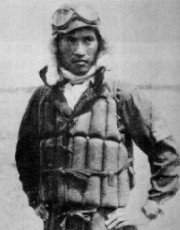
was a Japan
Japan
Japan is an island nation in East Asia. Located in the Pacific Ocean, it lies to the east of the Sea of Japan, China, North Korea, South Korea and Russia, stretching from the Sea of Okhotsk in the north to the East China Sea and Taiwan in the south...
ese naval aviator
Naval Aviator
A United States Naval Aviator is a qualified pilot in the United States Navy, Marine Corps or Coast Guard.-Naming Conventions:Most Naval Aviators are Unrestricted Line Officers; however, a small number of Limited Duty Officers and Chief Warrant Officers are also trained as Naval Aviators.Until 1981...
of the Imperial Japanese Navy
Imperial Japanese Navy
The Imperial Japanese Navy was the navy of the Empire of Japan from 1869 until 1947, when it was dissolved following Japan's constitutional renunciation of the use of force as a means of settling international disputes...
during World War II
World War II
World War II, or the Second World War , was a global conflict lasting from 1939 to 1945, involving most of the world's nations—including all of the great powers—eventually forming two opposing military alliances: the Allies and the Axis...
. As a kamikaze pilot
Kamikaze
The were suicide attacks by military aviators from the Empire of Japan against Allied naval vessels in the closing stages of the Pacific campaign of World War II, designed to destroy as many warships as possible....
Lieutenant Seki led one of the three fighter groups of the second official kamikaze attack in World War II (the first official attack was led by Yoshiyasu Kuno on 21 October 1944, unsuccessfully). Seki's final action took place on October 25, 1944, during the Battle of Leyte Gulf
Battle of Leyte Gulf
The Battle of Leyte Gulf, also called the "Battles for Leyte Gulf", and formerly known as the "Second Battle of the Philippine Sea", is generally considered to be the largest naval battle of World War II and, by some criteria, possibly the largest naval battle in history.It was fought in waters...
. He led a unit of five bomb-armed Mitsubishi Zero fighters, crash-diving their planes deliberately into St. Lo
USS St. Lo (CVE-63)
USS St. Lo was a of the United States Navy during World War II. On 25 October 1944, St. Lo became the first major warship to sink as the result of a kamikaze attack. The attack occurred during the Battle of Leyte Gulf.St...
, being the first kamikazes to sink an enemy ship.
Early life
Yukio Seki was born 1921 in Iyo Saijō, a small town in ShikokuShikoku
is the smallest and least populous of the four main islands of Japan, located south of Honshū and east of the island of Kyūshū. Its ancient names include Iyo-no-futana-shima , Iyo-shima , and Futana-shima...
. His parents ran an antiques store specializing in tea ceremony utensils. At an early age, Seki was exposed to Naval training courses at his middle school and planned a career in the Navy. Since naval personnel were fully prepared to die in battle, and since Yukio was an only child, the family adopted a daughter nearly Yukio's age to carry with the family affairs.
In 1938 he tried to get to the War Academy of both the Imperial Navy and the ground forces. He was accepted to both of them and he chose navy, attending the Japanese Naval Academy at Eta-Jima. During this time his father died and his mother closed the antiques shop and lived alone. In 1941, one month before the Pearl harbor attack, Seki graduated and was ordered to the Battleship Fusō
Japanese battleship Fuso
The Japanese battleship Fusō , was a part of the Imperial Japanese Navy, the lead ship of the Fusō-class. She was laid down by the Kure Kaigun Koshō on 11 March 1912, launched on 28 March 1914 and completed on 18 November 1915...
. In June of the same year he was promoted to Lieutenant. Soon he was transferred to the seaplane carrier Chitose
Japanese aircraft carrier Chitose
was a light aircraft carrier of the Imperial Japanese Navy during World War II. It should not be confused with the earlier cruiser of the same name. First laid down as a seaplane tender in 1934 at Kure Navy yard, the ship originally carried Kawanishi E7K Type 94 "Alf" and Nakajima E8N Type 95...
.
Service in World War II
Seki saw several naval actions, and participated in a minor role in the battle of MidwayBattle of Midway
The Battle of Midway is widely regarded as the most important naval battle of the Pacific Campaign of World War II. Between 4 and 7 June 1942, approximately one month after the Battle of the Coral Sea and six months after Japan's attack on Pearl Harbor, the United States Navy decisively defeated...
as his ship, Chitose, belonged to the second wave of Japanese ships.
In 1942 Seki returned to Japan and enrolled in the Naval flying academy in Kasumigaura, Ibaraki
Kasumigaura, Ibaraki
is a city located in Ibaraki, Japan. Kasumigaura was formerly a town in Niihari District and became a city on March 28, 2005 after merging with the neighboring town of Chiyoda, also from Niihari District. The city takes its name from the nearby lake, Lake Kasumigaura...
. After basic training he was transferred to Usa, Oita
Usa, Oita
' is a city located in Ōita Prefecture, Japan. Usa is famous for being the location of the Usa Shrine, built in 725, the head shrine of all of Hachiman shrines in Japan.Usa is made up of three areas.*Usa, the area surrounding the Usa Shrine...
to be trained as a dive bomber operating from carriers. In January 1944 he became instructor in Kasumigaura. Seki became friends with Watanabe family living in Kamakura and fell in love with their daughter Mariko. Once when he was out drinking with his colleagues one of them suggested that all of them should get married on the same day. They all agreed. The same weekend Seki went to Kamakura and proposed to Mariko while her mother was present. Mariko accepted the proposal and they were married May 31, 1944. Seki's mother Sekae was the only relative from his side to take part in the wedding. After the wedding she lived with the young couple for a month and then left saying "Young couples need some time alone". Soon after they moved into a house close to the flying academy.
In September 1944 Seki was transferred to Tainan, a city in Taiwan
Taiwan
Taiwan , also known, especially in the past, as Formosa , is the largest island of the same-named island group of East Asia in the western Pacific Ocean and located off the southeastern coast of mainland China. The island forms over 99% of the current territory of the Republic of China following...
. He had to leave his wife behind because Tainan was not safe enough for him to take her with him. Mariko followed Seki to Yokohama
Yokohama
is the capital city of Kanagawa Prefecture and the second largest city in Japan by population after Tokyo and most populous municipality of Japan. It lies on Tokyo Bay, south of Tokyo, in the Kantō region of the main island of Honshu...
to say goodbye to him. Three weeks after he had arrived in Tainan he was transferred again, this time to the 201st flotilla in Philippines as leader of 301st fighter unit. Their base was originally in Nicholas, but was later moved to Mabalacat away from increasing attacks by the Americans.
During this time Vice Admiral Takijiro Onishi had been making plans for the first Kamikaze attack, and Lieutenant Seki was given the opportunity by group commander Asaiki Tamai
Asaiki Tamai
Asaiki Tamai was a colonel in the Imperial Japanese Navy during World War II.-Early life:...
to lead a special attack squadron that would end in the loss of his own life. Seki is said to have closed his eyes, lowered his head and thought for ten seconds, before saying to Tamai: "Please do appoint me to the post." Seki thereby became the leader of the squadron "Shikishima" which conducted the first official Kamikaze attack, and the first to sink an enemy ship. Four times his group returned to base in aborted sorties.
The Kamikaze attack on Taffy 3
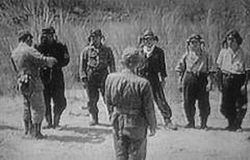
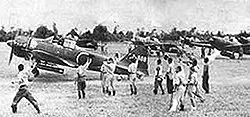
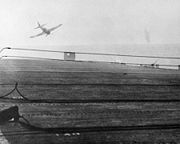
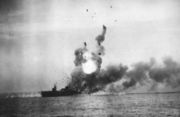
Hiroyoshi Nishizawa
Lieutenant Junior Grade was an ace of the Imperial Japanese Navy Air Service during World War II.It is possible that Nishizawa was the most successful Japanese fighter ace of the war; he personally claimed to have had 87 aerial victories at the time of his death...
, Misao Sugawa, Shingo Honda and Ryoji Baba. Their target was Vice admiral Clifton Sprague
Clifton Sprague
Vice Admiral Clifton Albert Frederick Sprague was a World War II-era officer in the United States Navy.-Biography:...
's "Taffy 3" Task force during their desperate defence of the landings in the Battle of Leyte Gulf
Battle of Leyte Gulf
The Battle of Leyte Gulf, also called the "Battles for Leyte Gulf", and formerly known as the "Second Battle of the Philippine Sea", is generally considered to be the largest naval battle of World War II and, by some criteria, possibly the largest naval battle in history.It was fought in waters...
. At 1050, Seki's squadron made their attack on four escort carriers of Taffy 3:
- USS White Plains (CVE-66)USS White Plains (CVE-66)USS White Plains was an Casablanca class escort carrier of the United States Navy.She was laid down on 11 February 1943 at Vancouver, Washington, by the Kaiser Shipbuilding Company, Inc., under a Maritime Commission contract as Elbour Bay ; renamed White Plains on 3 April 1943; redesignated...
: Two planes attack. AA fire scored a hit on one attacker who changed course for St. Lo. The second plane was destroyed by AA fire just yards astern of White Plains. No hit on White Plains, but debris was scattered on the aft deck causing 11 minor injuries. - USS Kalinin Bay (CVE-68)USS Kalinin Bay (CVE-68)USS Kalinin Bay was an Casablanca class escort carrier of the United States Navy.She originally designated an AVG, was classified ACV-68 on 20 August 1942; laid down under a Maritime Commission contract 26 April 1943 by the Kaiser Shipbuilding Co., Inc., Vancouver, Washington; reclassified CVE-68...
: Four diving planes attack from astern. Two planes are splashed by AA fire. Two hits by the others. One crashes into the port side of the flight deck, damaging it badly. The other hits the aft port stack, destroying it. - USS Kitkun Bay (CVE-71)USS Kitkun Bay (CVE-71)USS Kitkun Bay was a US Navy Casablanca class escort carrier launched on 8 November 1943.Originally designated as an AVG, was classified as ACV-71 on 20 August 1942 and reclassified as CVE-71 on 15 July 1943...
: Port catwalk clipped and aircraft explodes off the port side, causing one death and no significant damage. - USS St. Lo (CVE-63)USS St. Lo (CVE-63)USS St. Lo was a of the United States Navy during World War II. On 25 October 1944, St. Lo became the first major warship to sink as the result of a kamikaze attack. The attack occurred during the Battle of Leyte Gulf.St...
: The plane which veared off from White Plains approaches St. Lo, and her action report states "Approaching the ramp at very high speed, the 'Zeke 52' crossed over the aft end of the ship at less than fifty feet. He appeared to push over sufficiently to hit the deck at about the 'number 5 wire', fifteen feet to the port side of the center line. A tremendous crash followed quickly followed by an explosion as one or both of the enemy's bombs exploded. The aircraft continued up the deck leaving fragments strewed about and its remnents went over the bow." At first, the damage appeared minor. "There was a hole in the flight deck with smoldering edges which sprang into flame. Hoses were immediately run out from both sides of the flight deck and water started on the fire....smoke soon appeared on both sides of the ship, evidently coming from the hangar. Within one to one and one-half minutes an explosion occurred on the hangar deck, which puffed smoke and flame through the hole in the deck and bulged the flight deck near and aft of the hole. This was followed in a matter of seconds by a much more violent explosion, which rolled back a part of the flight deck bursting through aft of the original hole. The next heavy explosion tore out more of the flight deck and also blew the forward elevator out of its shaft." The magazine had detonated, and St. Lo was gone in half an hour.
According to the US Navy reports, there were no other kamikaze hits on US ships that day, although there was a "suicide" near miss on the Kitkun Bay which was destroyed by AA fire from the Kitkun Bay. Since this was at 1120- nearly one half hour later after Seki's attack, and because all 5 of Seki's Kamikazes were apparently expended, and because the attacking plane was a non kamikaze type Yokosuka D4Y
Yokosuka D4Y
The D4Y Navy Type 2 Carrier Dive bomber was operated by the Imperial Japanese Navy. Its Allied reporting name was "Judy". The D4Y was one of the fastest dive-bombers of the war, and only the delays in its development hindered its service, while its predecessor, the slower fixed gear Aichi D3A...
dive bomber, it is unlikely this was a member of Seki's group.
Controversies
It is debated whether Seki's plane sank the St. Lo. Nishizawa survived the attack and made his report stating that Seki's plane glanced off the deck of a carrier but that the bomb did not explode. His description on this point closely matches the attack on St. Lo as reported by her captain. A second plane did score a hit on the same carrier that Seki attacked and that plane's bomb did explode. The only carrier with two hits was the Kalinin Bay. However, the description is sharply different, since there was an immediate visibly large explosion following the first hit on the Kalinin Bay, and no portions of the plane were seen to go over the bow. So Nishizawa's description of Seki's hit most closely matches that on the St. Lo.Prior to Seki's mission, Masashi Onoda, a Domei war correspondent interviewed Yukio Seki and quotes him disparaging suicide attacks. "Japan's future is bleak if it is forced to kill one of its best pilots. I am not going on this mission for the Emperor or for the Empire... I am going because I was ordered to!" In this interview, he gives insight into his thinking on how the carrier force should be attacked. "If they would let me, I could drop a 500 kilogram bomb on the flight deck of a carrier without going in for body-crashing and still make my way back." During his flight, his commanders heard him say "It is better to die, rather than to live as a coward."
Whichever pilot actually sank the St. Lo did so by releasing his bomb onto the flight deck just as Seki described to the reporter, instead of crashing his plane directly onto the deck. The reports of the attack are consistent with that of a pilot who intended to return to base after successfully sinking the St. Lo.

